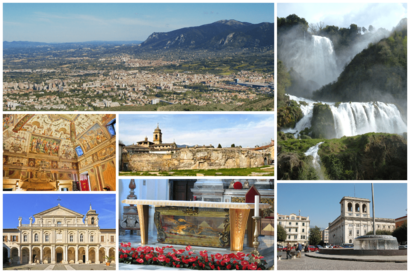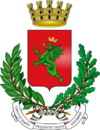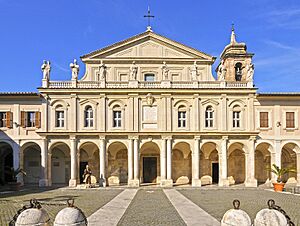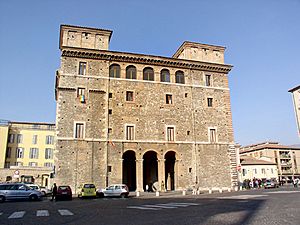Terni facts for kids
Quick facts for kids
Terni
|
|||
|---|---|---|---|
| Comune di Terni | |||
|
From top left, anti-clockwise: view of Terni; City Council Hall; Terni Cathedral; Relics of Saint Valentine; Piazza Tacito; and Marmore Waterfalls. In the middle: Anfiteatro Fausto.
|
|||
|
|||
| Country | Italy | ||
| Region | Umbria | ||
| Province | Terni (TR) | ||
| Frazioni | Acquapalombo, Appecano, Battiferro, Cecalocco, Cesi, Collegiacone, Collescipoli, Collestatte, Giuncano Alto, Giuncano Scalo, Marmore, Miranda, Papigno, Piediluco, Poggio Lavarino, Polenaco, Porzano, Pracchia, Rocca San Zenone, San Carlo, San Liberatore, Titurano, Torreorsina | ||
| Area | |||
| • Total | 211.9 km2 (81.8 sq mi) | ||
| Elevation | 130 m (430 ft) | ||
| Population
(31 July 2023)
|
|||
| • Total | 106,065 | ||
| • Density | 500.54/km2 (1,296.40/sq mi) | ||
| Demonym(s) | Ternani | ||
| Time zone | UTC+1 (CET) | ||
| • Summer (DST) | UTC+2 (CEST) | ||
| Postal code |
05100
|
||
| Dialing code | 0744 | ||
| Patron saint | Saint Valentine | ||
| Saint day | February 14 | ||
Terni is a city in the southern part of Umbria, a region in Central Italy. It is close to the border with Lazio. Terni is the main city of the province of Terni. It sits in the flat area of the River Nera. The city is about 104 kilometers (65 miles) northeast of Rome. It is also 81 kilometers (50 miles) south of Perugia, which is the capital of the Umbria region.
The name Terni comes from a Latin phrase meaning "between-two-rivers." This is because the city is located where the Nera river and the Serra stream meet. People from Terni were called Interamnātēs Na(ha)rtēs in ancient Latin.
Terni was first founded as an ancient Roman town. However, people lived in the Terni area long before the Romans arrived. In the 1800s, steel factories were built here. This made Terni very important during Italy's Second Industrial Revolution. Because of its factories, the city was heavily bombed during World War II by the Allies. Today, Terni is still a major industrial center. It is often called "The Steel City."
Terni is also known as the "City of Lovers." This is because its patron saint, Saint Valentine, was born here and became a bishop in the city. His remains are kept in a special church built in his honor.
Contents
History of Terni
The city of Terni was started around 700 BC by the Umbrians people called Nahartes. People had lived in this area since the Bronze Age, as shown by old discoveries. Ancient writings describe the Nahartes as a strong and large group. They were a major rival of the Umbrian people from Gubbio.
Roman Times and Water Issues
In the 3rd century BC, the Romans took control of Terni. It quickly became an important town called Interamna. This name means "between-two-rivers." The town was located on the important Via Flaminia road.
In 271 BC, a Roman leader named Manius Curius Dentatus ordered a canal to be built. This canal, called the Curiano Trench, moved water from marshes and a lake. It sent the water over a cliff at Marmore, creating a waterfall. This caused floods in the valley around Terni. For a long time, this led to many arguments between the cities of Rieti and Terni. The problem was so big that the Roman Senate had to discuss it in 54 BC. Even then, the problem was not solved for centuries.
Middle Ages and Later Changes
After the Lombard people took over in 755, Terni became less important. It was just a small town in the Duchy of Spoleto. In 1174, a general named Christian of Mainz attacked and looted the city. In the next century, St. Francis often visited Terni to give speeches.
In the 1300s, Terni created its own rules for how the city would be run. From 1353, the city walls were made bigger, and new canals were dug. Like many Italian towns in the Late Middle Ages, Terni had internal fights. Different groups, like the Nobili and Banderari, argued for power. Later, Terni joined the Papal States.
In 1580, an ironwork factory, called the Ferriera, was started. It used iron ore from nearby mines. This began Terni's long history as an industrial city. However, in the 1600s, the number of people in Terni went down. This was due to diseases and food shortages.
Industrial Growth and World War II
In the 1800s, Terni grew a lot thanks to the Industrial Revolution. The city had plenty of water, which was good for factories. New industries included steelworks, a foundry, and factories for weapons, jute, and wool. In 1927, Terni became the capital of its own province.
Because of its important factories, Terni was a main target for Allied bombings during World War II. On August 11, 1943, 44 American bombers attacked the city. They dropped 213 tons of bombs, killing 564 people. This was the first of 57 air raids that damaged or destroyed 40% of Terni's buildings. A total of 1,018 civilians died. Despite this damage, industry in Terni quickly grew again after the war.
Climate in Terni
Terni has a climate with warm summers and mild winters. The hottest months are July and August, when the average high temperature is around 33°C (91°F). The coldest months are January and December, with average low temperatures around 2-4°C (36-39°F). The city gets the most rain in November and October. The driest month is July.
Terni's Economy
Terni has three main industrial areas. The first is the Stainless Steel Area, known as AST. This is a large area in the eastern part of the city. It is part of the ThyssenKrupp group.
To the west of Terni, there is a second industrial area called "Area Polymer." Here, you can find four different international chemical companies.
The third industrial area is Italeaf. This company controls TerniEnergia, which is listed on the Italian stock exchange. TerniEnergia works in the field of renewable energy. It also helps new technology companies grow in the cleantech sector.
Getting Around Terni
Terni is connected to the A1 motorway, the European route E45, and the National Road Flaminia. These connections are made through a special motorway junction called the RATO.
Terni railway station is on the main railway line that goes from Ancona to Orte. It is also a junction station for two smaller railway lines. One line connects Terni with L'Aquila. The other line, called FCU, serves Perugia. One of Italy's most important freight train stations is also located nearby.
The local bus service, ATC, has 90 bus lines that help people get around the city and its nearby areas. In the northern part of the city, work is being done to turn the railway line from Perugia into a Light rail line.
Places to See in Terni
Terni has many interesting places to visit, including old churches and historical buildings.
Religious Sites
- Terni Cathedral (Duomo, Cattedrale di Santa Maria Assunta) (17th century). This church was built over one of the city's oldest Christian buildings. Today, it looks like a Baroque style church. Inside, there is an organ designed by the famous artist Gian Lorenzo Bernini. The bell tower was built in the 1700s. The front of the church has two medieval gates. One gate has the shape of a shoe that was used to measure people's shoes. This was to make sure their shoes were not too big.
- San Cristoforo: A church from the 12th century.
- San Francesco: A church built in the 13th century.
- San Valentino: This is the Basilica church dedicated to Saint Valentine.
- Sant'Alò: An 11th-century Romanesque church.
- San Martino: Another Romanesque church.
- San Salvatore: A Romanesque church.
Secular and Civic Sites
- Roman Amphitheater: This ancient Roman theater was built in 32 BC. It could hold 10,000 people.
- Porta Sant'Angelo: This is one of the four old Roman gates that led into the city. It has been repaired many times.
- Palazzo Mazzancolli: This building is one of the few remaining examples of the city's medieval past.
- Palazzo Gazzoli (18th century): This building houses the city's art gallery. It has artworks by artists like Pierfrancesco d'Amelia and Benozzo Gozzoli.
- Palazzo Spada (16th century): This palace was designed by Antonio da Sangallo the Younger. It is now the city's Town Hall.
- Lancia di Luce ("Lance of Light"): This is a large sculpture created by the artist Arnaldo Pomodoro.
- Cascata delle Marmore: This is a 165-meter (541-foot) high waterfall located nearby. It was created by the Romans where the Velino and Nera Rivers meet. It is the tallest man-made waterfall in the world.
Sports in Terni
Ternana Calcio is the main football (soccer) club in Terni. The team has played twice in Italy's top football league, Serie A. These seasons were 1972–1973 and 1974–1975. Ternana is currently playing in Serie B (as of the 2021–2022 season).
The club plays its games at the Stadio Libero Liberati. This stadium can hold 22,000 fans. It is named after Libero Liberati, a motorcycle racer born in Terni. He won the 500cc World Championship in 1957. He sadly died while training near Terni.
Famous People from Terni
Many important people have come from Terni throughout history.
Historical Figures
- Andrea Castelli da Terni (14th-15th century): A brave leader and hero of Terni. He was also a politician.
- Blessed brother Barnaba Manassei (15th century): He is famous for setting up the Monti di Pietà. This was a system to help poor families and cities deal with high interest rates on loans.
- Saint Valentine: A bishop and saint who was martyred.
- Saints Berardo, Ottone, Pietro, Accursio and Adiuto: These were 13th-century Franciscan saints.
Notable People
- Francesco Angeloni: A historian, art collector, and writer.
- Baconin Borzacchini: A Grand Prix motor racing driver.
- Giulio Briccialdi: A composer and flautist.
- Alessio Foconi: A fencer.
- Libero Liberati: A famous motorcycle racer, known as "The Steel Knight." He was the 1957 500cc Grand Prix World Champion.
- Danilo Petrucci: A Moto GP racer.
- Claudio Petruccioli: A politician and journalist.
- Gaius Cornelius Tacitus: A famous Roman historian.
- Marcus Claudius Tacitus: A Roman emperor.
- Paolo Tagliavento: An international football referee.
- Lorela Cubaj: A WNBA basketball player.
Terni's Sister Cities
Terni has special connections with other cities around the world. These are called sister cities.
 Cartagena, Spain
Cartagena, Spain Dunaújváros, Hungary
Dunaújváros, Hungary Saint-Ouen-sur-Seine, France
Saint-Ouen-sur-Seine, France
See also
 In Spanish: Terni para niños
In Spanish: Terni para niños







